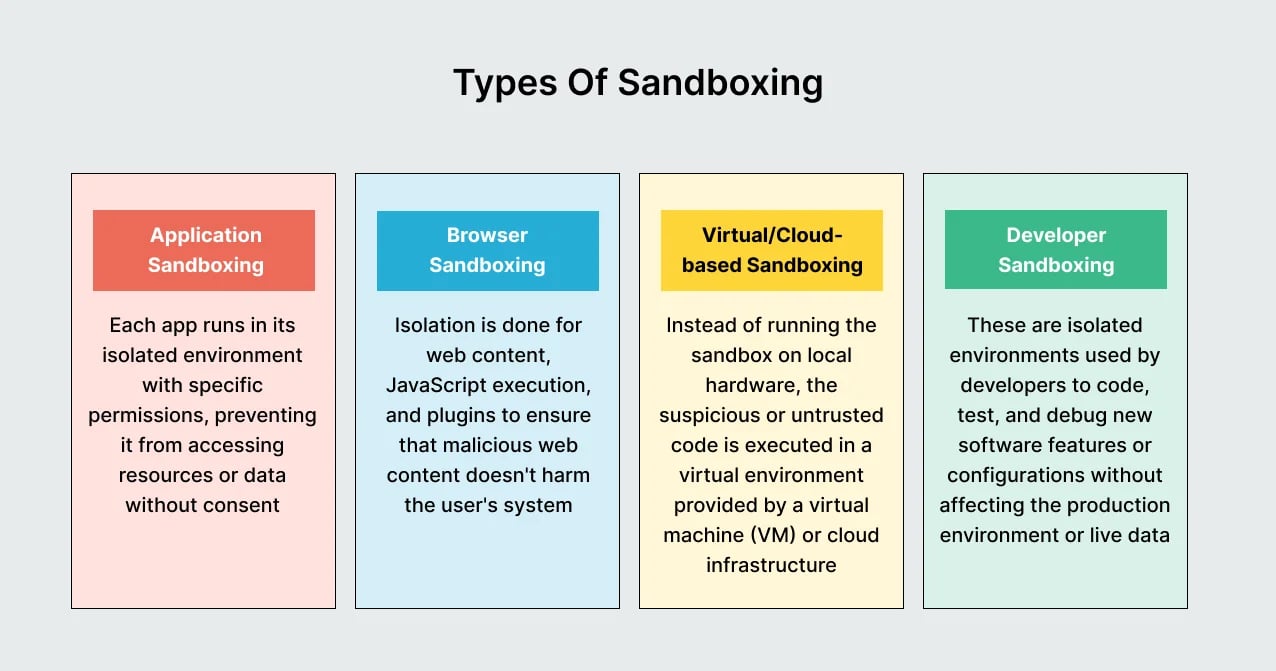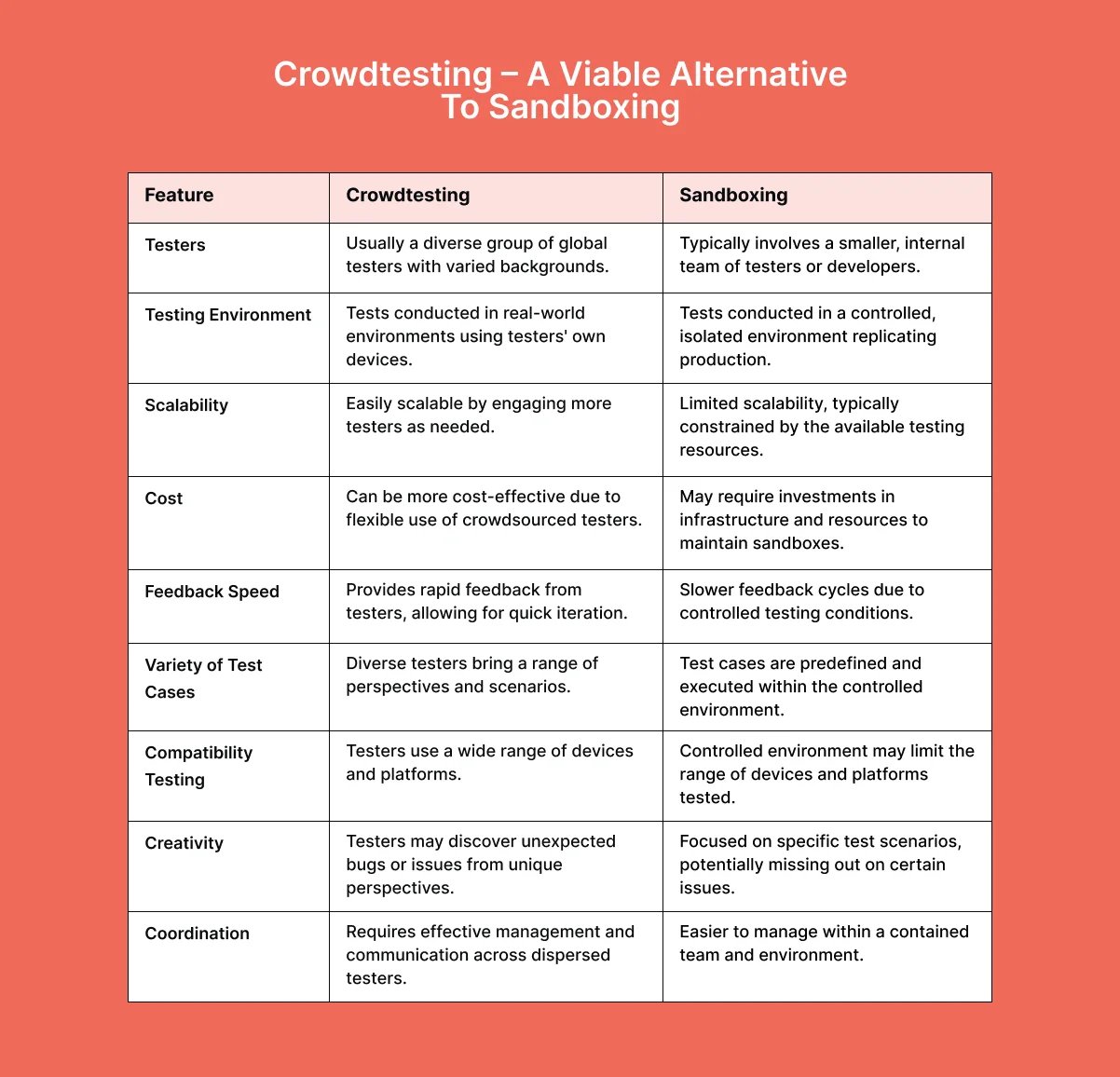What is a sandbox in software testing?
How can developers and testers safely experiment with new code changes without risking disruptions to the live production environment? The answer lies in using a sandbox – a secure, isolated testing environment. But what is a sandbox in software testing, when should you use it, and are there any potential drawbacks or alternatives? Read along to find out!
We can help you drive sandbox in software testing as a key initiative aligned to your business goals
What is a sandbox?
A sandbox is a testing area where developers and testers can safely try out new features and code changes during software development. This secure space lets them experiment without disrupting live systems or real-world data centers.
Sandboxes are also helpful for learning new skills, as they provide a hands-on way to explore different features and tools. Using a sandbox, teams can test and learn confidently without risking problems in their main systems.
Why do you need a sandbox?
The main goal of a sandbox is to offer a safe space for testing new software or running untrusted code. As a result, it helps maintain the main system's stability, security, and privacy.
Thus, using it in software testing ensures higher-quality software, smoother deployments, and a better user experience.
What are the different types of sandboxing?
There are various types of sandbox environments, including:
- Application sandboxing that confines individual applications to a secure environment is commonly found in operating systems and mobile apps. It restricts access to system resources and data, ensuring the application cannot impact the broader system.
- Web browser sandboxing: In this setup, web browser activities are kept separate from the rest of the system. Each website or tab runs in its own sandbox, protecting the user's computer from malicious websites or downloads.
- Security sandboxing: Cybersecurity experts use security sandboxes to examine suspicious code, malware, or potential threats in a controlled environment.
- Network sandboxing analyzes network traffic and detects threats such as viruses, worms, or other malware before they compromise the network.
- Cloud-based or virtual sandboxing allows testing and assessing threats without relying on physical hardware.
- Developer sandboxing gives coders a dedicated, isolated space to write and test their code.

Benefits of using a sandbox
Using a sandbox offers several significant advantages:
- Sandboxes act as a robust defense against malware and cyber threats by containing potentially harmful software in a controlled space. This ensures the safety and integrity of broader systems and critical data.
- By isolating programs and applications, they prevent interference between different software, contributing to overall system stability and reliability.
- Safeguarding user privacy by restricting programs and applications from accessing sensitive user data, creating a barrier against unauthorized access.
- They provide a safe space for testing new software or running untrusted code, allowing developers to identify and resolve issues before deployment.
- Sandboxes can serve as a secure zone for examining suspicious emails and attachments, allowing administrators to verify potential threats without risking system safety.
- Developers benefit from sandboxing as it provides a secure testing ground for new code, updates, or entire applications, enabling issues to be resolved without impacting the production environment.
- They are designed to be intuitive, allowing employees without a technical background to isolate and examine suspicious programs safely.
- It is a cost-effective approach that prevents costly security breaches and software glitches after deployment.
- Sandboxes provide an ongoing feedback loop, enabling continuous improvement in security protocols as new threats and software behaviors are encountered.
Drawbacks of using a sandbox
While sandboxes provide many benefits, they also have a few drawbacks:
- Performance impact: Running programs and applications in a sandbox can sometimes introduce overhead, affecting performance.
- Configuration complexity: For enterprise users, setting up and managing sandboxes can be complex and may require specialized knowledge.
- False positives: They can sometimes incorrectly flag legitimate programs and applications as malicious, leading to potential disruptions.
How to use sandbox in test automation?
Sandboxes are a vital component of test automation, offering a safe, efficient, and controlled environment for executing tests. Here's a more detailed explanation:
1. Isolation:
- A sandbox creates a dedicated space away from the main production environment, allowing tests to run independently. This means that the automated tests can execute without interfering with live applications.
- By isolating tests, sandboxes prevent the automated tests from inadvertently affecting other parts of the system or data that could skew results.
2. Early detection:
- Running tests in a sandbox allows developers and testers to identify issues as soon as possible, reducing the risk of defects reaching the production environment.
- Automated tests in a sandbox provide immediate feedback, enabling rapid iteration and improvement of the software.
3. Reproducibility:
- Sandboxes offer a consistent environment for running tests repeatedly, making it easier to reproduce failures and investigate issues.
- Testers can control the testing conditions, ensuring that tests are performed under the same circumstances each time.
4. Risk reduction:
- Sandboxes allow testers to execute risky tests without affecting the live system, such as testing potential vulnerabilities or edge cases.
- By isolating tests, sandboxes ensure that potential bugs or security vulnerabilities are addressed before reaching production.
5. Scalability:
- They are easy to scale up or down depending on testing needs, making it possible to run multiple tests in parallel or perform large-scale testing.
- The use of resources is efficient and it allows teams to allocate specific environments for different tests.
6. Integration testing:
- It is a controlled space for conducting integration tests, where various components and services are tested together.
- By mirroring the production environment, sandboxes enable accurate testing of how different system parts interact.
7. Continuous integration and delivery:
- It supports CI/CD pipelines by providing a stable testing environment for automated tests as part of the development and deployment process.
- Automated tests in a sandbox ensure continuous software testing, allowing for rapid development and deployment cycles.
8. Learning and experimentation:
- It is a safe space to experiment with new testing frameworks, methodologies, and tools.
How to use sandbox – Manual vs automated testing
Both manual and automated testing approaches use sandboxes for thorough testing in a controlled environment. Here's a breakdown of how to use it in each workflow:
Manual testing in a sandbox:
- Environment setup: Create a sandbox that mimics the production environment to ensure realistic testing conditions.
- Test planning: Establish testing objectives and strategies, detailing which manual tests to conduct.
- Preparation: Develop manual test cases and gather necessary test data, including various input types for thorough testing.
- Execution and analysis: Manually execute test cases within the sandbox, observe results, and log findings.
- Regression and exploratory testing: Retest fixed areas to confirm resolutions and conduct exploratory testing for additional issues.
- Feedback and review: Collect input from testers, developers, and stakeholders to evaluate the software's performance and compliance with criteria.
- Release planning: Decide on deployment based on testing outcomes and proceed with releasing the application if it meets quality standards.
Automated testing in a sandbox:
- Environment setup: Set up a sandbox environment closely resembling production for accurate automated testing.
- Test automation strategy: Define the scope and objectives for automation, and select appropriate testing tools.
- Script creation: Develop automated test scripts to cover necessary test cases, including functional and regression tests.
- Data management: Prepare or generate test data using automated processes.
- Integration into CI/CD: Incorporate automated tests into the CI/CD pipeline for continuous testing and deployment.
Example of sandboxing in software testing
Let’s say you are developing a new feature for an e-commerce website, like a personalized shopping cart. In that case, the process includes the following steps:
- Create a sandbox environment that mimics the production environment, including user data, database structures, and network configurations.
- Design comprehensive test cases to validate the new feature, such as adding items to the shopping cart and proceeding to checkout.
- Prepare a variety of test data, including valid and invalid inputs, to evaluate the feature's behavior under different conditions.
- Execute the test cases in the sandbox and record the results, including the outcomes of each test case, error messages, and any unexpected behaviors.
- Identify and document any issues that arise, for instance, a crash during the checkout process or unexpected results when applying specific discount codes.
- Compile detailed reports and share them with the development team.
- Retest the feature after implementing any necessary fixes, and include regression testing.
- Deploy the feature to the production environment after successful retesting.
Crowdtesting – a viable alternative to sandboxing
Crowdtesting offers a unique and flexible approach to software testing that can complement traditional sandboxing methods:

Global App Testing, a leader in this field, provides advanced crowdtesting services that you can use as an alternative or supplement to traditional sandboxing:
- Over 90,000 skilled testers worldwide ensure the software is tested across various languages, cultures, devices, and network conditions.
- Testers work in their own natural environments, using their personal devices and setups, offering a genuine perspective on how the software will perform for actual users in different regions and markets.
- With GAT, you can rapidly scale testing teams based on project needs, whether for larger projects or specific test cases.
- Crowdtesting is more cost-efficient than maintaining in-house testing teams or complex sandbox environments.
- It provides fast, iterative feedback, as testers can be engaged on demand. Global App Testing's platform ensures seamless integration into development processes for real-time results and adjustments.
- Testers' diverse perspectives often uncover unexpected bugs or issues that may not appear in controlled sandbox environments.
Interested to learn more? Let's schedule a call with our QA specialist today!
We can help you drive sandbox in software testing as a key initiative aligned to your business goals
FAQ
Can sandboxing be used with other testing methods?
Yes, sandboxing can be combined with other testing methods, such as automated testing and crowdtesting, to provide a comprehensive testing strategy.
What is the difference between a sandbox and a developer environment?
Sandbox environment:
- A sandbox is a virtual environment used for building, testing, and deploying software.
- It is an isolated and secure space where new code can be run and tested without affecting live apps and data.
- Sandboxes mimic real-world conditions, allowing developers and testers to identify and fix bugs, experiment with new software, and learn new technologies safely.
- Sandboxes provide a consequence-free space for testing software patches, studying malicious code, and conducting training.
Developer environment:
- A developer environment is a workspace specifically for software developers to build software.
- It is not designed for extensive testing or deployment of new software.
- The environment may not accurately replicate real-life deployment conditions as it focuses on software creation.
- Non-developers may find developer environments less accessible and challenging to use for testing purposes.
How do you set up a sandbox environment?
- Decide whether to use virtual machines (VMs), containers, or other software based on your needs and how you plan to deploy your application.
- Install sandboxing tools like Docker or VirtualBox to create and manage your sandbox environment.
- Set up the resources and configure access settings to keep the environment isolated and secure, protecting your main system.
Keep learning
12 Payment gateway testing interview questions
What is Automation Testing? - Everything You Need To Know
A guide to outsourced software testing

